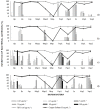Biomimetic Approaches for the Development of New Antifouling Solutions: Study of Incorporation of Macroalgae and Sponge Extracts for the Development of New Environmentally-Friendly Coatings
- PMID: 31574976
- PMCID: PMC6801554
- DOI: 10.3390/ijms20194863
Biomimetic Approaches for the Development of New Antifouling Solutions: Study of Incorporation of Macroalgae and Sponge Extracts for the Development of New Environmentally-Friendly Coatings
Abstract
Biofouling causes major economic losses in the maritime industry. In our site study, the Bay of La Paz (Gulf of California), biofouling on immersed structures is a major problem and is treated mostly with copper-based antifouling paints. Due to the known environmental effect of such treatments, the search for environmentally friendly alternatives in this zone of high biodiversity is a priority to ensure the conservation and protection of species. The aim of this work was to link chemical ecology to marine biotechnology: indeed, the natural defense of macroalgae and sponge was evaluated against biofoulers (biofilm and macrofoulers) from the same geographical zone, and some coatings formulation was done for field assays. Our approach combines in vitro and field bioassays to ensure the selection of the best AF agent prospects. The 1st step consisted of the selection of macroalgae (5 species) and sponges (2 species) with surfaces harboring a low level of colonizers; then extracts were prepared and assayed for toxicity against Artemia, activity towards key marine bacteria involved in biofilm formation in the Bay of La Paz, and the potency to inhibit adhesion of macroorganisms (phenoloxidase assays). The most active and non-toxic extracts were further studied for biofouling activity in the adhesion of the bacteria involved in biofilm formation and through incorporation in marine coatings which were immersed in La Paz Bay during 40 days. In vitro assays demonstrated that extracts of Laurencia gardneri, Sargassum horridum (macroalgae), Haliclona caerulea and Ircinia sp. (sponges) were the most promising. The field test results were of high interest as the best formulation were composed of extracts of H. caerulea and S. horridum and led to a reduction of 32% of biofouling compared with the control.
Keywords: Haliclona caerulea; Ircinia sp.; Laurencia gardneri; Sargassum horridum; adhesion; algae; antifouling; biofilm; extracts; field assays; sponges.
Conflict of interest statement
The authors declare no conflict of interest.
Figures




Similar articles
-
Exploring Antifouling Activity of Biosurfactants Producing Marine Bacteria Isolated from Gulf of California.Int J Mol Sci. 2020 Aug 23;21(17):6068. doi: 10.3390/ijms21176068. Int J Mol Sci. 2020. PMID: 32842499 Free PMC article.
-
Sponge-Inspired Dibromohemibastadin Prevents and Disrupts Bacterial Biofilms without Toxicity.Mar Drugs. 2017 Jul 12;15(7):222. doi: 10.3390/md15070222. Mar Drugs. 2017. PMID: 28704947 Free PMC article.
-
Protocol for Assessing Antifouling Activities of Macroalgal Extracts.Methods Mol Biol. 2015;1308:421-35. doi: 10.1007/978-1-4939-2684-8_27. Methods Mol Biol. 2015. PMID: 26108522
-
Proof of Concept of Natural and Synthetic Antifouling Agents in Coatings.Mar Drugs. 2024 Jun 24;22(7):291. doi: 10.3390/md22070291. Mar Drugs. 2024. PMID: 39057400 Free PMC article. Review.
-
Principles of biofouling protection in marine sponges: a model for the design of novel biomimetic and bio-inspired coatings in the marine environment?Mar Biotechnol (NY). 2013 Aug;15(4):375-98. doi: 10.1007/s10126-013-9497-0. Epub 2013 Mar 26. Mar Biotechnol (NY). 2013. PMID: 23525893 Review.
Cited by
-
Metabolomic Insights of Biosurfactant Activity from Bacillus niabensis against Planktonic Cells and Biofilm of Pseudomonas stutzeri Involved in Marine Biofouling.Int J Mol Sci. 2023 Feb 20;24(4):4249. doi: 10.3390/ijms24044249. Int J Mol Sci. 2023. PMID: 36835662 Free PMC article.
-
Biofouling inhibition by Staphylococcus aureus extracts and their potential use for paints.Int Microbiol. 2024 Feb;27(1):81-90. doi: 10.1007/s10123-023-00371-z. Epub 2023 May 11. Int Microbiol. 2024. PMID: 37166536
-
Antifouling Activity of Halogenated Compounds Derived from the Red Alga Sphaerococcus coronopifolius: Potential for the Development of Environmentally Friendly Solutions.Mar Drugs. 2021 Dec 28;20(1):32. doi: 10.3390/md20010032. Mar Drugs. 2021. PMID: 35049887 Free PMC article.
-
Integrated Biological and Chemical Investigation of Indonesian Marine Organisms Targeting Anti-Quorum-Sensing, Anti-Biofilm, Anti-Biofouling, and Anti-Biocorrosion Activities.Molecules. 2025 Mar 7;30(6):1202. doi: 10.3390/molecules30061202. Molecules. 2025. PMID: 40141983 Free PMC article.
-
Impact of Marine Chemical Ecology Research on the Discovery and Development of New Pharmaceuticals.Mar Drugs. 2023 Mar 9;21(3):174. doi: 10.3390/md21030174. Mar Drugs. 2023. PMID: 36976223 Free PMC article. Review.
References
-
- Sriyutha M., Venugopalan V.P., Nair K.V.K., Subramonian T. Larval settlement and surface: Implications in development of antifouling strategies. In: Flemming H.C., Sriyutha M., Venkatesan R., Cooksey K., editors. Marine and Industrial Biofouling. Volume 4. Springer; Berlin/Heidelberg, Germany: 2009. pp. 233–264. - DOI
-
- Eguía E., Trueba A. Application of marine biotechnology in the production of natural biocides for testing on environmentally innocuous antifouling coatings. J. Coat. Technol. Res. 2007;4:191–202. doi: 10.1007/s11998-007-9022-3. - DOI
-
- Isensee J., Watermann B., Berger H.D. Emissions of antifouling- biocides into the North Sea—An estimation. Dtsch. Hydrogr. Z. 1994;46:355–365. doi: 10.1007/BF02226311. - DOI
MeSH terms
Substances
LinkOut - more resources
Full Text Sources

